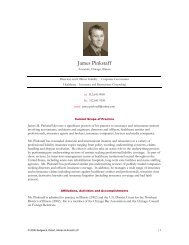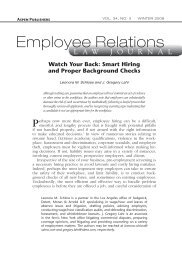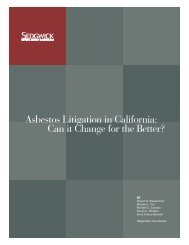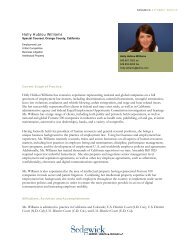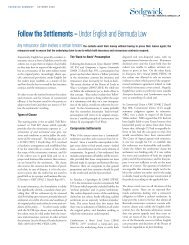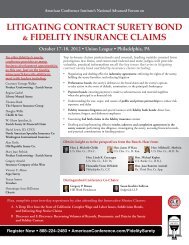Download Case Summaries in PDF Format - Sedgwick LLP
Download Case Summaries in PDF Format - Sedgwick LLP
Download Case Summaries in PDF Format - Sedgwick LLP
Create successful ePaper yourself
Turn your PDF publications into a flip-book with our unique Google optimized e-Paper software.
SEDGWICK 2010 CEQA ROUNDUP<br />
Because the start<strong>in</strong>g po<strong>in</strong>t of any EIR analysis is the project description, the project description should be a focal<br />
po<strong>in</strong>t of considerable attention to ensure that it meets the standards for adequacy under CEQA. Here, the project<br />
description failed <strong>in</strong> two critical respects by confus<strong>in</strong>gly and <strong>in</strong>coherently address<strong>in</strong>g the project’s technical,<br />
economic and environmental characteristics and fail<strong>in</strong>g to provide an adequate statement of project objectives.<br />
Conversely, <strong>in</strong> a separate yet related section of the case, the court upheld the EIR aga<strong>in</strong>st a challenge that it<br />
impermissibly segmented the impacts of the project by not analyz<strong>in</strong>g as part of the project the impacts of a<br />
proposed pipel<strong>in</strong>e to transport excess hydrogen from the plant. The court reasoned that “the hydrogen pipel<strong>in</strong>e<br />
and the Ref<strong>in</strong>ery upgrade, are <strong>in</strong>dependently justified, separate projects with different project proponents – not<br />
piecemealed components of the same project.” 184 Cal.App.4 th at 99. The court also observed that the agency<br />
properly <strong>in</strong>cluded the proposed pipel<strong>in</strong>e <strong>in</strong> the cumulative impact analysis for the proposed Ref<strong>in</strong>ery upgrade.<br />
California Oak Foundation v. Regents of University of California, 188 Cal.App.4th 227 (2010)<br />
This case <strong>in</strong>volved the <strong>in</strong>famous tree sitters <strong>in</strong> the oak trees outside of Memorial Stadium on the UC Berkeley<br />
campus. The pla<strong>in</strong>tiffs challenged the adequacy of the EIR on many grounds. This summary focuses on the<br />
claim that the project description was <strong>in</strong>adequate and that the statement of project objectives was defective. The<br />
court’s discussion and conclusions will be helpful go<strong>in</strong>g forward because of the court’s conclusions regard<strong>in</strong>g the<br />
requirements for an adequate project description and statement of project objectives.<br />
The court first noted that only four items are mandatory for an adequate project description: (1) a detailed map<br />
with the precise location and boundaries of the proposed project; (2) a statement of project objectives; (3) a<br />
general description of the project’s technical, economic and environmental characteristics; and (4) a statement<br />
briefly describ<strong>in</strong>g the <strong>in</strong>tended uses of the EIR and list<strong>in</strong>g the agencies <strong>in</strong>volved with and the approvals required<br />
for implementation. The court then noted that the CEQA Guidel<strong>in</strong>es state that a project description should not<br />
supply extensive detail beyond that needed for evaluation and review of a project’s environmental impact. With<br />
this as a basis for the court’s analysis, the court then exam<strong>in</strong>ed the claimed defects <strong>in</strong> the project description,<br />
focus<strong>in</strong>g on two particular aspects of the project claimed by the pla<strong>in</strong>tiffs to be examples of the defects <strong>in</strong> the<br />
project description. After exam<strong>in</strong><strong>in</strong>g the pla<strong>in</strong>tiffs’ claims, the court found that the EIR’s project description was<br />
compliant with the requirements of the CEQA Guidel<strong>in</strong>es and therefore was adequate. Helpfully, the court also<br />
noted that, even though the EIR provided more detail with respect to the first phase of the project (which was<br />
the only phase of the project be<strong>in</strong>g presented for f<strong>in</strong>al approval), the commitment of the University to prepare<br />
additional EIRs <strong>in</strong> the future, if necessary, if the amount of detail provided for any other phase of the project<br />
proved <strong>in</strong>adequate was a proper use of tier<strong>in</strong>g under CEQA. As the court observed, “Further, where an EIR<br />
covers several possible projects that are diverse and geographically dispersed, the agency has discretion to evaluate<br />
the potential environmental impacts of the <strong>in</strong>dividual projects <strong>in</strong> general terms <strong>in</strong> the EIR, while deferr<strong>in</strong>g more<br />
detailed evaluation of the projects for future EIRs.” 188 Cal.App.4 th at 271. Because the project description was<br />
compliant with CEQA, the EIR conta<strong>in</strong>ed enough detail to permit reasonable and mean<strong>in</strong>gful environmental<br />
review of each phase of the project <strong>in</strong> connection with the EIR’s certification.



